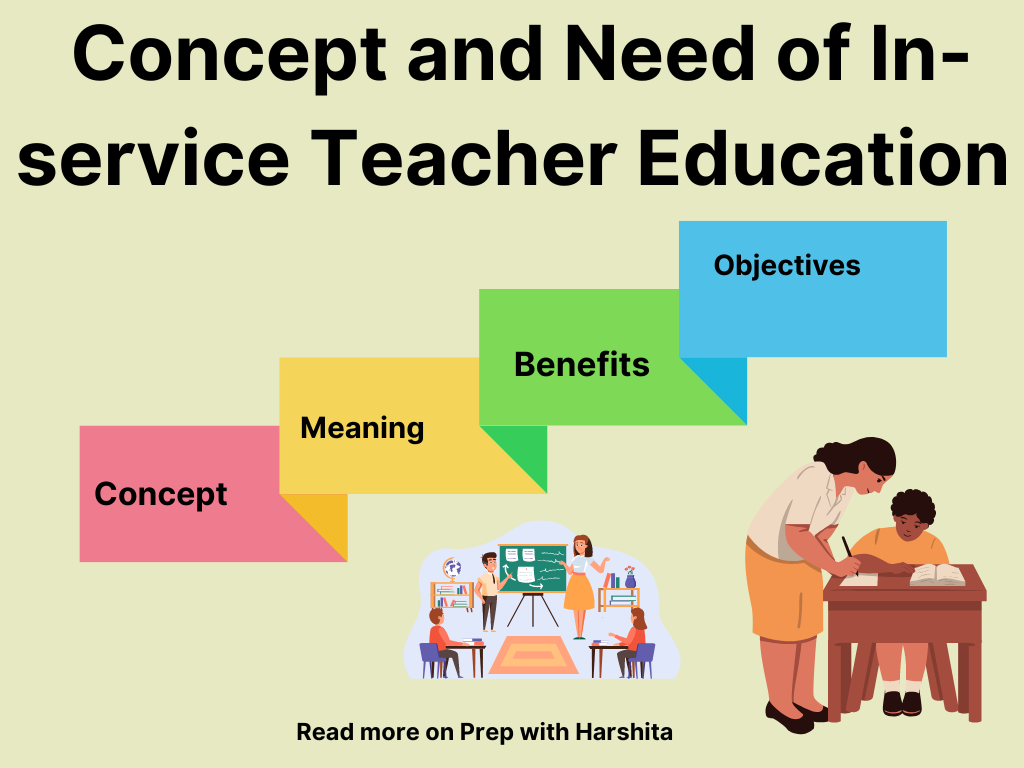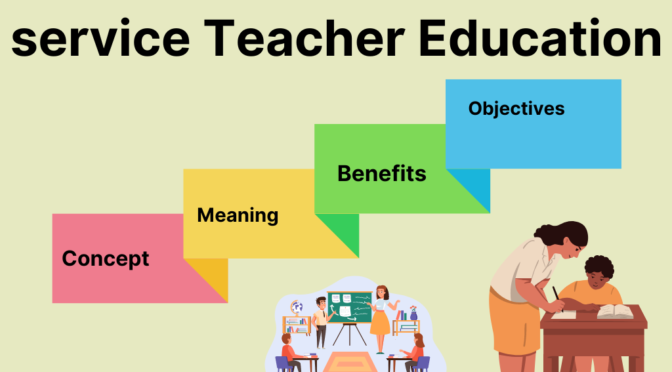In-service teacher education refers to the professional development and training opportunities provided to teachers who are already working in schools. It is designed to enhance the knowledge, skills, and teaching practices of in-service teachers, enabling them to improve their instructional effectiveness and meet the evolving needs of students.
Concept of In-service Teacher Education:
The concept of in-service teacher education recognizes that teaching is a dynamic profession that requires continuous learning and growth. It acknowledges that teachers need ongoing support and training throughout their careers to stay updated with educational research, emerging pedagogical approaches, and advancements in their subject areas.
Need of In-service Teacher Education :
The need for in-service teacher education is multi-faceted and encompasses various aspects that are essential for the continuous professional development of teachers. Here is a detailed explanation of the need for in-service teacher education:
- Pedagogical Development: In-service teacher education helps teachers refine their pedagogical skills and instructional strategies. It provides opportunities for teachers to learn about and implement effective teaching methods, assessment techniques, classroom management strategies, and student engagement practices. Through in-service education, teachers can enhance their ability to create dynamic, student-centered learning environments.
- Subject Knowledge Enhancement: In-service teacher education programs contribute to improving teachers’ subject knowledge and expertise. They provide opportunities for teachers to deepen their understanding of subject content, stay updated with the latest research, and explore innovative teaching approaches. Enhanced subject knowledge enables teachers to deliver accurate and meaningful instruction to their students.
- Keeping Pace with Educational Reforms: Educational systems undergo frequent reforms, including changes in curriculum, assessment practices, and teaching methodologies. In-service teacher education helps teachers adapt to these changes by providing them with the necessary knowledge, skills, and support to implement educational reforms effectively. It ensures that teachers are aligned with the latest educational policies and are able to meet the evolving needs of students.
- Addressing Diverse Student Needs: In-service teacher education acknowledges the diverse backgrounds, abilities, and learning styles of students. It equips teachers with strategies to differentiate instruction, cater to individual student needs, and create inclusive classrooms. In-service education provides teachers with tools and techniques to support diverse learners, including those with special needs or from culturally diverse backgrounds.
- Integration of Educational Technology: In-service teacher education addresses the need to integrate educational technology into teaching practices. It equips teachers with the skills and knowledge required to effectively use technology tools, digital resources, and online platforms to enhance instruction, engage students, and promote digital literacy. By incorporating technology, teachers can create more engaging and interactive learning experiences for students.
- Reflective Practice and Professional Growth: In-service teacher education encourages teachers to engage in reflective practice, self-assessment, and professional growth. It provides opportunities for teachers to reflect on their teaching practices, identify areas for improvement, and collaborate with colleagues to enhance their instructional effectiveness. In-service education programs facilitate self-directed learning and encourage teachers to take ownership of their professional development.
- Networking and Collaboration: In-service teacher education fosters networking and collaboration among teachers. It creates spaces for teachers to interact, share experiences, exchange ideas, and collaborate on instructional strategies. Peer learning and collaboration can be instrumental in improving teaching practices, expanding knowledge, and creating a supportive professional community.
- Improved Student Outcomes: Ultimately, the need for in-service teacher education is driven by the goal of improving student outcomes. Quality in-service education programs lead to enhanced teaching practices, increased student engagement, improved academic achievement, and positive learning experiences. By continually developing their skills and knowledge, teachers can provide high-quality education and contribute to the overall success of their students.
In summary, in-service teacher education is needed to support the professional development of teachers, enhance pedagogical skills, adapt to educational reforms, address diverse student needs, integrate technology, promote reflective practice, foster collaboration, and ultimately improve student outcomes. It is an essential component of a continuously evolving and effective education system.
Also Read: Educational Sociology

Also Visit: Prep with Harshita


3 thoughts on “Concept and Need of In-service Teacher Education”